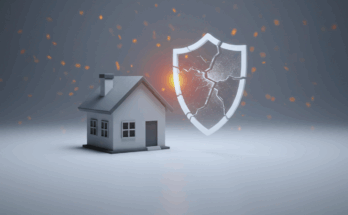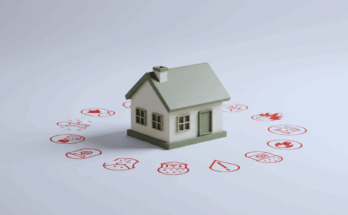Property insurance is a critical safeguard for homeowners and property investors, offering financial protection against unexpected events like natural disasters, theft, or accidents. However, navigating the world of property insurance can be complex, and mistakes can lead to inadequate coverage, higher costs, or denied claims. To help you make informed decisions, here are five common mistakes to avoid when insuring your property, along with practical tips to ensure your coverage meets your needs.

1. Underinsuring Your Property
One of the most significant errors property owners make is underinsuring their property. Underinsurance occurs when the coverage amount is less than the actual cost to rebuild or replace the property in the event of a total loss. This often happens when owners base their coverage on the market value of the property rather than its replacement cost, which includes rebuilding expenses, labor, and materials.
For example, if your home is valued at $300,000 on the market but rebuilding costs are $400,000 due to rising material prices, insuring for only the market value leaves you $100,000 short in a worst-case scenario. According to industry data, underinsured properties can result in owners covering 20-40% of repair costs out of pocket, which can be financially devastating.
➢ How to Avoid It: Work with your insurance provider to calculate the replacement cost accurately. Consider factors like local construction costs, the size and age of your property, and any unique features (e.g., custom fixtures). Review your policy annually to account for inflation or renovations that increase your property’s value. Many insurers offer tools or professional appraisals to estimate replacement costs accurately.
2. Not Understanding Policy Exclusions
Every insurance policy has exclusions specific events or damages not covered. Many property owners fail to read the fine print and assume their policy covers all potential risks. Common exclusions include floods, earthquakes, mold, or wear-and-tear damages. For instance, standard homeowners’ insurance typically does not cover flood damage, which affects over 14 million U.S. homes in high-risk flood zones, according to FEMA.
Failing to understand these exclusions can leave you vulnerable. A homeowner in a coastal area might assume their policy covers hurricane-related flooding, only to discover after a storm that they needed separate flood insurance.
➢ How to Avoid It: Carefully review your policy’s exclusions and discuss them with your insurance agent. If you live in an area prone to specific risks, such as earthquakes in California or hurricanes in Florida, purchase additional coverage like flood or earthquake insurance. The National Flood Insurance Program (NFIP) or private insurers can provide flood policies, while earthquake coverage is often available as an add-on.
3. Overlooking Liability Coverage
Liability coverage is a critical component of property insurance that protects you if someone is injured on your property or if you accidentally cause damage to someone else’s property. Many property owners undervalue or overlook this coverage, focusing only on physical damage to their home or belongings. However, lawsuits from injuries or accidents can lead to significant financial losses. For example, if a guest slips on your icy driveway and sues for medical expenses, inadequate liability coverage could leave you paying out of pocket.
➢ How to Avoid It: Ensure your policy includes sufficient liability coverage, typically at least $300,000 for homeowners. If you have high-value assets or frequent visitors (e.g., tenants, guests, or workers), consider an umbrella policy, which provides additional liability protection beyond your standard policy. Umbrella policies are often cost-effective, with annual premiums as low as $150-$300 for $1 million in coverage, according to the Insurance Information Institute.
4. Failing to Document Your Belongings
When filing a claim for damaged or stolen personal property, you’ll need to provide proof of ownership and value. Many property owners neglect to document their belongings, making it difficult to receive full reimbursement. Without proper documentation, insurers may undervalue or deny claims for items like electronics, jewelry, or furniture. In 2024, the average claim for personal property loss was around $10,000, yet many homeowners struggled to substantiate their losses due to poor records.
➢ How to Avoid It: Create a home inventory by photographing or videotaping your belongings, focusing on high-value items. Store receipts, appraisals, or serial numbers in a secure location, such as a cloud-based platform or a safe deposit box. Update your inventory annually or after major purchases. Many insurers offer free apps to streamline this process, ensuring you have evidence to support claims.
5. Not Shopping Around for Policies
Many property owners stick with the first insurance provider they find or renew their policy without comparing options, potentially missing out on better coverage or lower premiums. Insurance rates and offerings vary widely between providers due to differences in risk assessment, discounts, and policy features. For instance, some insurers offer discounts for home security systems, bundling policies, or being claim-free, which can reduce premiums by 5-20%.
Failing to shop around can also mean missing out on specialized coverage tailored to your needs, such as policies for historic homes or vacation properties. In 2025, the average annual homeowners’ insurance premium is around $1,400, but shopping around can save hundreds of dollars annually.
➢ How to Avoid It: Compare quotes from at least three insurers before purchasing or renewing a policy. Use online comparison tools or work with an independent insurance agent who can access multiple providers. Ask about discounts, such as those for installing smoke detectors, deadbolts, or storm shutters. Ensure you’re comparing similar coverage levels to make an informed decision.
Additional Tips for Smart Property Insurance
→ Beyond avoiding these mistakes, consider these proactive steps to optimize your property insurance:
- Update Your Policy Regularly: Major life changes, such as renovations, adding a pool, or starting a home-based business, can affect your coverage needs. Notify your insurer promptly to adjust your policy.
- Understand Deductibles: Higher deductibles can lower premiums but increase out-of-pocket costs during a claim. Choose a deductible you can afford in an emergency.
- Leverage Technology: Smart home devices, like leak detectors or security cameras, can reduce risks and sometimes qualify for premium discounts.
- Read Reviews and Ratings: Check insurer ratings from organizations like AM Best or J.D. Power to ensure financial stability and customer satisfaction.
Conclusion
Insuring your property is a vital step in protecting your financial future, but it requires careful consideration to avoid common pitfalls. By ensuring adequate coverage, understanding policy exclusions, prioritizing liability protection, documenting your belongings, and shopping around for the best policy, you can secure peace of mind and avoid costly surprises. Take the time to review your policy, consult with professionals, and stay informed about your coverage needs. With these precautions, you’ll be better equipped to protect your property and weather any storm, literal or figurative that comes your way.

![[Home Insurance vs. Condo Insurance] Key Differences You Must Know](https://luzo.top/wp-content/uploads/2025/08/home-insurance-vs-condo-insurance-key-differences-you-must-know-348x215.png)

